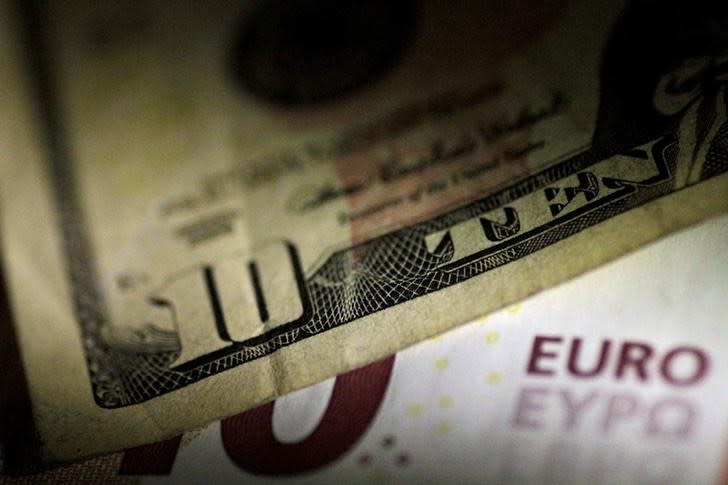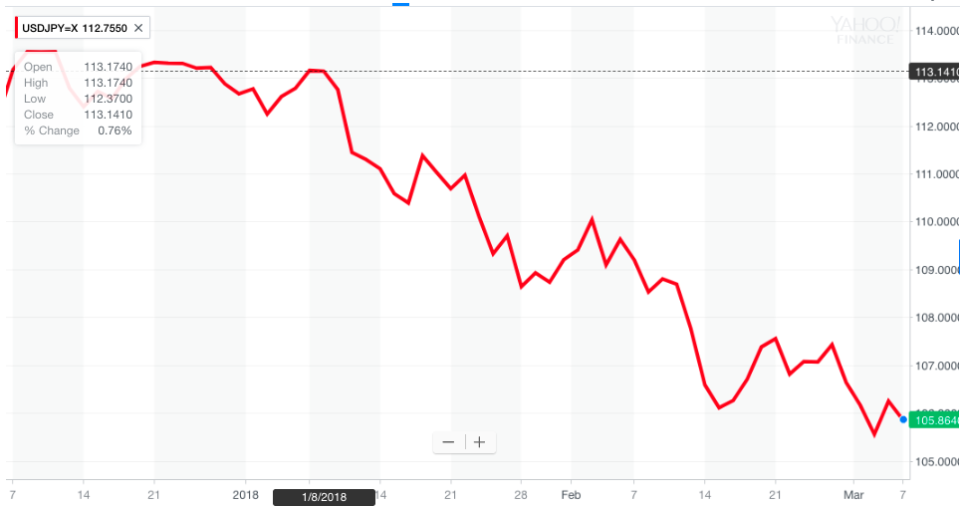The dollar is warning of a big economic slowdown, analysts say
The value of the dollar has further to fall, analysts say, and some argue it will sink much further before it’s all said and done. And that fall may come in concert with the global economic recovery economists and market analysts have been championing about since last year.
U.S. President Donald Trump’s proposed tariffs risk igniting a global trade war that could scuttle the market’s sanguine mood and hurt growth globally, analysts told Yahoo Finance. And nowhere is that fear of an undermined rally more evident than in the dollar’s value against the Japanese yen.
The dollar has fallen nearly 7% against the yen since its 2018 high on Jan. 8. That’s a nearly 34% annualized loss, according to data from Bloomberg.

“When the global economy is just starting to come out of crisis, the one thing that will absolutely disrupt this virtuous cycle is a trade war and this is the first salvo in the trade war,” said Boris Schlossberg, BK Asset Management’s managing director of FX strategy, of the proposed tariffs. “The yen is reflecting this faster, stronger and more intensely than any other instrument.”

The warnings about the tariffs’ negative impact on economies globally was voiced most recently by International Monetary Fund Managing Director Christine Lagarde.
“If world trade were jeopardized by such measures, they would become a vector for lower growth and a slowdown of commerce. The impact on growth would be a formidable,” Lagarde said.
The dollar has historically been pummeled by fears of protectionism and tariffs. When former Presidents George W. Bush and Bill Clinton previously introduced wide-ranging tariffs in 2002 and 1995 currency markets sold the dollar, pushing its value lower by 15% overall, according to data from TD Securities.
The resignation of National Economic Council Director Gary Cohn, the top White House economic policy adviser, has markets believing the tariffs could be a reality, with the dollar again showing weakness, prices of U.S. Treasury bonds falling lower and the stock market tumbling.
Trump’s proposals for 25% tariffs on steel and 10% tariffs on aluminum may be advanced this week, despite warnings of reprisals from U.S. allies including the European Union, China and NAFTA partners Mexico and Canada.
“The voices of reason in the White House are dwindling and the risk of a trade war is increasing,” Commerzbank strategists wrote in a note to clients.
Tariffs are viewed as negative by most economists and market participants because they can increase the price of foreign products in the United States, reducing demand and imports. They can reduce the value of the dollar because the tariffs typically mean money flows out of the United States and into safe-haven currencies like the yen.
Selling of the dollar could pick up significantly
The biggest risk for the dollar stems from the possible exodus of capital flows, analysts said. If risk sentiment worsens significantly, this would outweigh any short-term advantage the dollar would have against emerging markets in its role as a safe-haven bet, they said.
Douglas Borthwick, managing director at Chapdelaine Foreign Exchange, expects selling of the dollar to pick up significantly. He’s expecting the dollar to fall below 100 yen per dollar by year-end, past its 16-month low touched late last week to the lowest the dollar has been against the Japanese currency since late 2013.
Analysts also are expecting the dollar to weaken against other currencies, such as the euro, British pound and Swiss franc. In fact, selling of the dollar could pick up after the release of the U.S. jobs report on Friday and the conclusion of policy meetings by the European Central Bank, Bank of Japan, Reserve Bank of Australia and Bank of Canada all taking place before Friday.
Borthwick believes the dollar could weaken 25% against the euro in the medium term before making any sort of recovery, “because of tariffs but also because of the stated goals of the [Trump] administration to have a weaker dollar,” he said.
TD Securities North American Head of FX Strategy Mark McCormick said the strong currency moves are part of a “regime change” happening in currency markets. He expects the dollar will be pulled lower by market forces as well as political ones as Trump’s policies worsen the U.S. fiscal deficit and its current account deficit, which he predicts could reach 8% of the country’s gross domestic product, or around $1.5 trillion.
With trade war fears simmering and investors pulling their money from the United States and possibly finding more attractive locations elsewhere, something’s got to give.
“You’re basically looking at an environment where the U.S. will have extreme funding requirements which will require foreign investors,” McCormick said. “So the countries Trump’s trying to poke with trade wars and other political rhetoric are the same countries that will fund U.S. deficits. You need either higher interest rates in the U.S. or a weaker dollar to offset that.”
—
Dion Rabouin is a markets reporter for Yahoo Finance. Follow him on Twitter: @DionRabouin.
Follow Yahoo Finance on Facebook, Twitter, Instagram, and LinkedIn.


